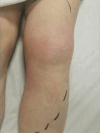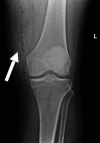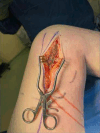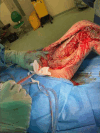Lower limb necrotising fasciitis descending from malignant colonic perforation: a rare pattern
- PMID: 39694653
- PMCID: PMC11667148
- DOI: 10.1136/bcr-2024-262470
Lower limb necrotising fasciitis descending from malignant colonic perforation: a rare pattern
Abstract
Necrotising fasciitis (NF) is a rare surgical emergency characterised by soft tissue necrosis and systemic compromise. Typically it originates following adjacent skin and soft tissue insult; however, our unusual case required a high index of clinical suspicion to avert potential mortality. A man in his 60s with diabetes mellitus presented with 2 weeks of knee pain, swelling and necrotic skin on the posterior calf. X-ray demonstrated subcutaneous emphysema. Initial debridement confirmed extensive necrotising fasciitis of the whole lower limb with tracking through femoral canal into the abdomen. CT confirmed sigmoid colon perforation. Both life-saving Hartmann's and hip disarticulation procedures were performed with good outcomes. Histology confirmed locally invasive sigmoid colon adenocarcinoma. Our case highlights lower limb necrotising fasciitis as a rare complication secondary to sigmoid perforation associated with malignancy. In cases where the infection nidus cannot be identified, an abdominal source should be considered.
Keywords: Bone and joint infections; Colon cancer; Gas/Free Gas; Orthopaedic and trauma surgery.
© BMJ Publishing Group Limited 2024. Re-use permitted under CC BY-NC. No commercial re-use. See rights and permissions. Published by BMJ.
Conflict of interest statement
Competing interests: None declared.
Figures











Similar articles
-
Necrotising fasciitis of the thigh secondary to colonic perforation: the femoral canal as a route for infective spread.J Plast Reconstr Aesthet Surg. 2012 Dec;65(12):1731-3. doi: 10.1016/j.bjps.2012.04.006. Epub 2012 Apr 25. J Plast Reconstr Aesthet Surg. 2012. PMID: 22541736
-
Not your usual hip pain: necrotising fasciitis secondary to sigmoid perforation.BMJ Case Rep. 2019 Mar 14;12(3):e228985. doi: 10.1136/bcr-2018-228985. BMJ Case Rep. 2019. PMID: 30872346 Free PMC article.
-
Necrotizing fasciitis of the lower extremity secondary to a perforated rectosigmoid tumor.Indian J Cancer. 2021 Oct-Dec;58(4):603-607. doi: 10.4103/ijc.IJC_670_20. Indian J Cancer. 2021. PMID: 34975101
-
Necrotising fasciitis of the leg following a simple pelvic fracture: case report and literature review.J Wound Care. 2006 Mar;15(3):117-20. doi: 10.12968/jowc.2006.15.3.26875. J Wound Care. 2006. PMID: 16550665 Review.
-
Necrotizing Fasciitis of the Thigh as Unusual Colonoscopic Polypectomy Complication: Review of the Literature with Case Presentation.Medicina (Kaunas). 2022 Jan 15;58(1):131. doi: 10.3390/medicina58010131. Medicina (Kaunas). 2022. PMID: 35056439 Free PMC article. Review.
References
Publication types
MeSH terms
LinkOut - more resources
Full Text Sources
